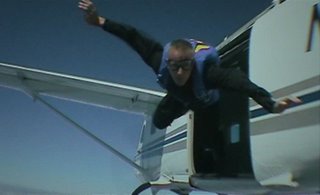
"Between 1930 and 1961 72 out of 75 birdmen died trying to achieve their dream," states the BirdMan manual. This statistic has been batted around in just about every web site, article, and conversation that touches upon the history of the wingsuit. I repeated it myself in a story for ForbesFYI several years ago. And the British Parachute Association has a web page that says "72 out of the 75 skydivers who became birdmen lost their lives in the pursuit of human flight." Popular Science ran an article (shortly after the ForbesFYI piece, I hasten to point out) claiming that "From 1930 to the early 1960s, out of 75 actively experimenting birdmen, 72 were killed in the pursuit." As I'd rather not tire you with more variations on the same sentence, let's just stop right now and say "etc." For the time has come to deal with this statistic head on.
Where, you ask, do these numbers come from? And I answer thusly: From a book called
Parachuting Folklore by Michael Horan. On page 76 of that work we find the following:
Roy "Red" Grant, self proclaimed as the last of the birdmen, estimates there were never more than seventy-five of these characters. He figures three quit the business, he is alive and the rest of the batmen made a big hole in the ground."
Now, there's a lot that can be said about these words. By Mr. Grant's count we should say either that 71 of 75 birdmen survived or that 72 of 76 survived. Who's to blame for the shoddy arithmetic, I don't know. Martin Caidin, in his
Barnstorming, starts a chapter on Grant by saying that "there have been only seventy-six
batmen" and goes on to say that Grant is the "last of the breed." Caidin's book came first (1965) so we can't assume another batman cropped up on the scene between the publication of the two books. Regardless, Grant was neither the last of the birdmen nor the last of the breed. Several batwing jumpers flew for the first time not long after he retired, to say nothing of today's flockers. Already we see that his word can be questioned, never mind the "estimates" of the paragraph above.
Soon after I published my own regurgitation of this dubious data I got a call from Charlie Laurin informing me that he
and his pal Art Lussier were two of the original batmen (can you see where this is going?). Further research revealed that Earl Stein was likely one of the survivors. That made three, four if you counted Grant. And then there was Private Bannister, then Donnie Marshall, then Don R. Bost, just to name a few of the men that turned out to have finished their winged careers intact. Furthermore, many of the batwing jumpers that died during their batwing heyday met their end in plane crashes and wing-free parachute jumps. Certainly there were many that died in their wings (all the main innovators, in fact), but the percentage, it seems, was less than 50.
Maybe you call this nitpicking, maybe you think "who cares?" but I believe that if you look closely you will find one of those "deeper issues" lurking behind the oft repeated numbers. The fact is, this little factoid (or falstoid, apparently) is a juicy one. It's one that people don't want to let go of. I'll go so far as to guess that some of you are disappointed that the fatalities aren't as high as it first appeared. But many of these batwing jumpers, however they perished, are just numbers, not names—we don't even know if there were as many as 75. So I suppose wishing that more of them had died in wings doesn't have to mean you wish any one of them had died in wings.
Here's evidence that we enjoy the frisson that comes with a higher body count. In
Birdmen, Batmen, and Skyflyers, I mention the 72 out of 75 bit, but explain the source (and it's spuriousness) in a footnote on the same page. Several reviewers ignored the footnote and repeated the "estimation" in their reviews as if it were fact.
Now that we've set the record straight I hope you will help me, if not to eradicate the error, at least to convince journalists and manual-writers and even flight-minded conversationalists, to include a qualifier such as "according to one birdman" or "so goes the lore" or "if you can believe such hyperbole" or "so we'd morbidly like to believe,"
etc.
Above you can see one of the nameless batwing jumpers. If you recognize him, do send a speedy note.
 A question posed by the Icarus Report on May 3rd, 2006, has been resolved. Wingsuit flyer and birdman historian Francis Heilmann tells us that it's highly unlikely that Jean Durand the batwing jumper is the same man as Jean Durand the stunt flyer who lived in or visited the U.S. in 1928. J.D. of the batwings was a French soldier who flew in 1950 with wings of silk. In 1951, after a particularly terriflying (that was a typo, but I'm leaving it in) flight filled with spins he decided to put down the wings for good, thus saving his life.
A question posed by the Icarus Report on May 3rd, 2006, has been resolved. Wingsuit flyer and birdman historian Francis Heilmann tells us that it's highly unlikely that Jean Durand the batwing jumper is the same man as Jean Durand the stunt flyer who lived in or visited the U.S. in 1928. J.D. of the batwings was a French soldier who flew in 1950 with wings of silk. In 1951, after a particularly terriflying (that was a typo, but I'm leaving it in) flight filled with spins he decided to put down the wings for good, thus saving his life.

